A Case Study of Uber: Examining Disruptive Innovation in ICT
VerifiedAdded on 2023/06/05
|10
|2831
|330
Case Study
AI Summary
This case study examines Uber as a prime example of disruptive innovation within the ICT sector. It explores how Uber, with limited resources, effectively challenged established industry players by focusing on underserved customer segments and offering more accessible and affordable services. The analysis covers Uber's innovative design, entrepreneurial spirit, and application of business analytics, highlighting its strategic accomplishments and impact on the market. The study concludes that Uber's success lies in its ability to identify and capitalize on opportunities that incumbents overlooked, ultimately transforming the transportation industry. Desklib offers a wealth of similar case studies and academic resources for students.
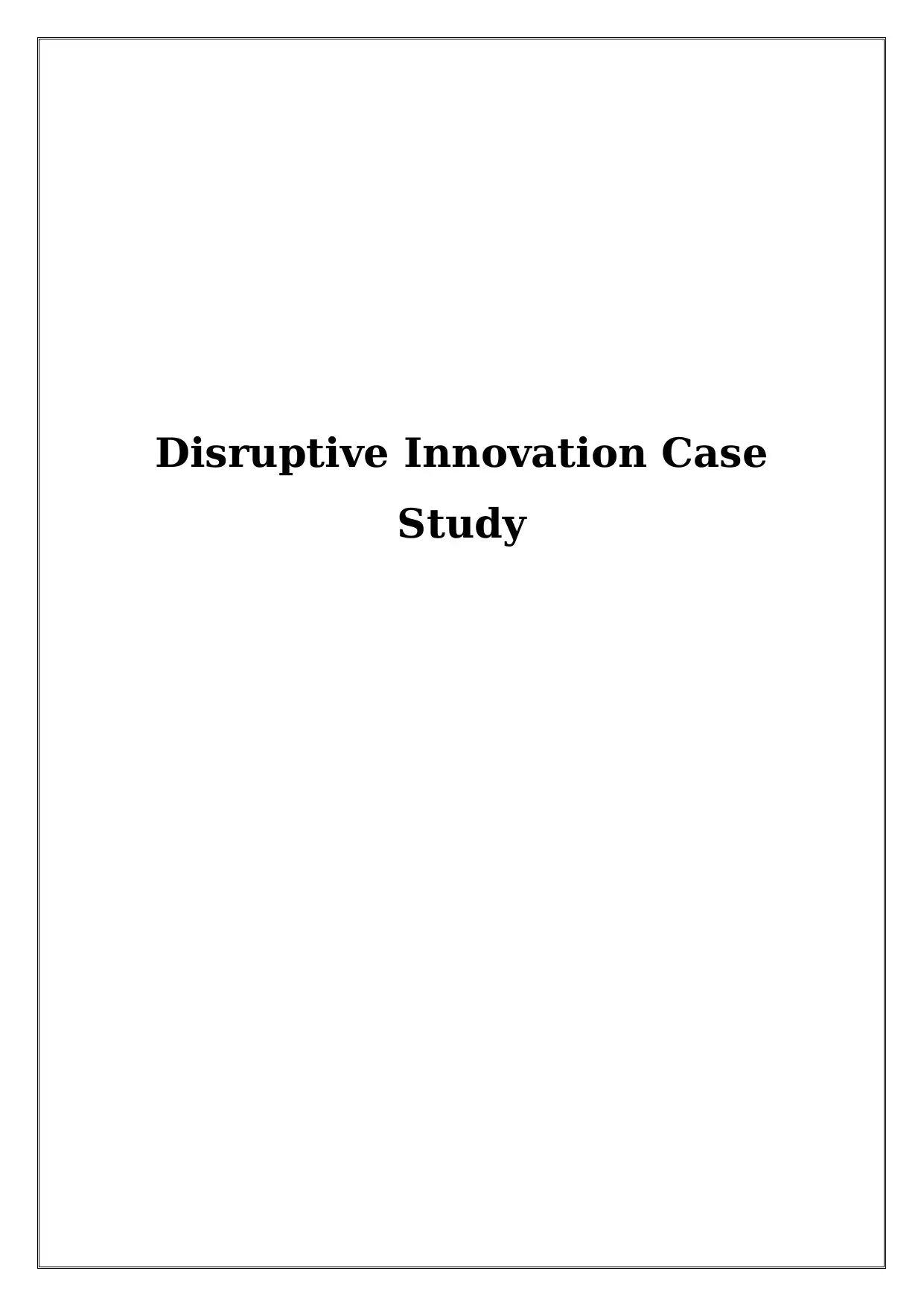
Disruptive Innovation Case
Study
Study
Paraphrase This Document
Need a fresh take? Get an instant paraphrase of this document with our AI Paraphraser
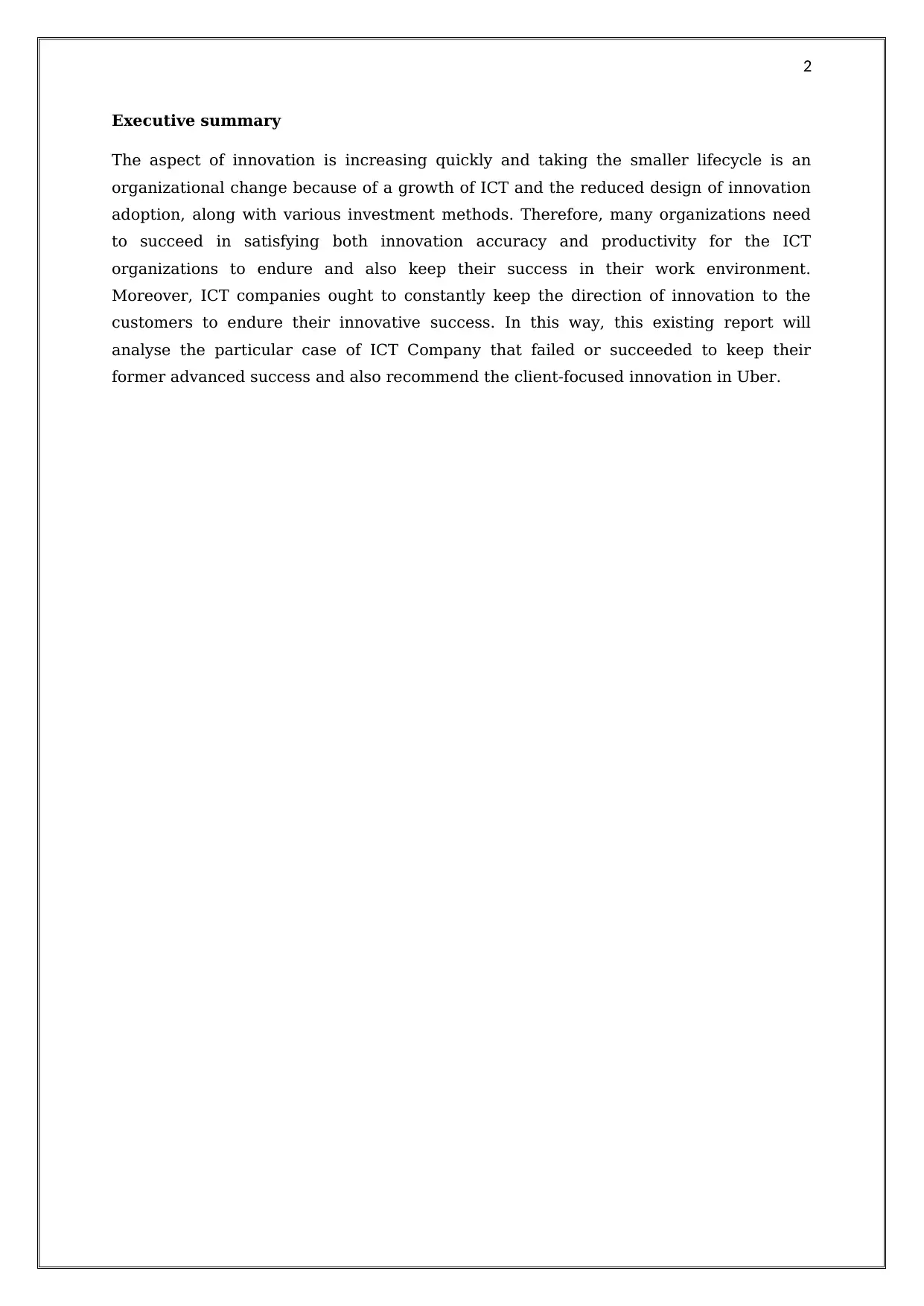
2
Executive summary
The aspect of innovation is increasing quickly and taking the smaller lifecycle is an
organizational change because of a growth of ICT and the reduced design of innovation
adoption, along with various investment methods. Therefore, many organizations need
to succeed in satisfying both innovation accuracy and productivity for the ICT
organizations to endure and also keep their success in their work environment.
Moreover, ICT companies ought to constantly keep the direction of innovation to the
customers to endure their innovative success. In this way, this existing report will
analyse the particular case of ICT Company that failed or succeeded to keep their
former advanced success and also recommend the client-focused innovation in Uber.
Executive summary
The aspect of innovation is increasing quickly and taking the smaller lifecycle is an
organizational change because of a growth of ICT and the reduced design of innovation
adoption, along with various investment methods. Therefore, many organizations need
to succeed in satisfying both innovation accuracy and productivity for the ICT
organizations to endure and also keep their success in their work environment.
Moreover, ICT companies ought to constantly keep the direction of innovation to the
customers to endure their innovative success. In this way, this existing report will
analyse the particular case of ICT Company that failed or succeeded to keep their
former advanced success and also recommend the client-focused innovation in Uber.
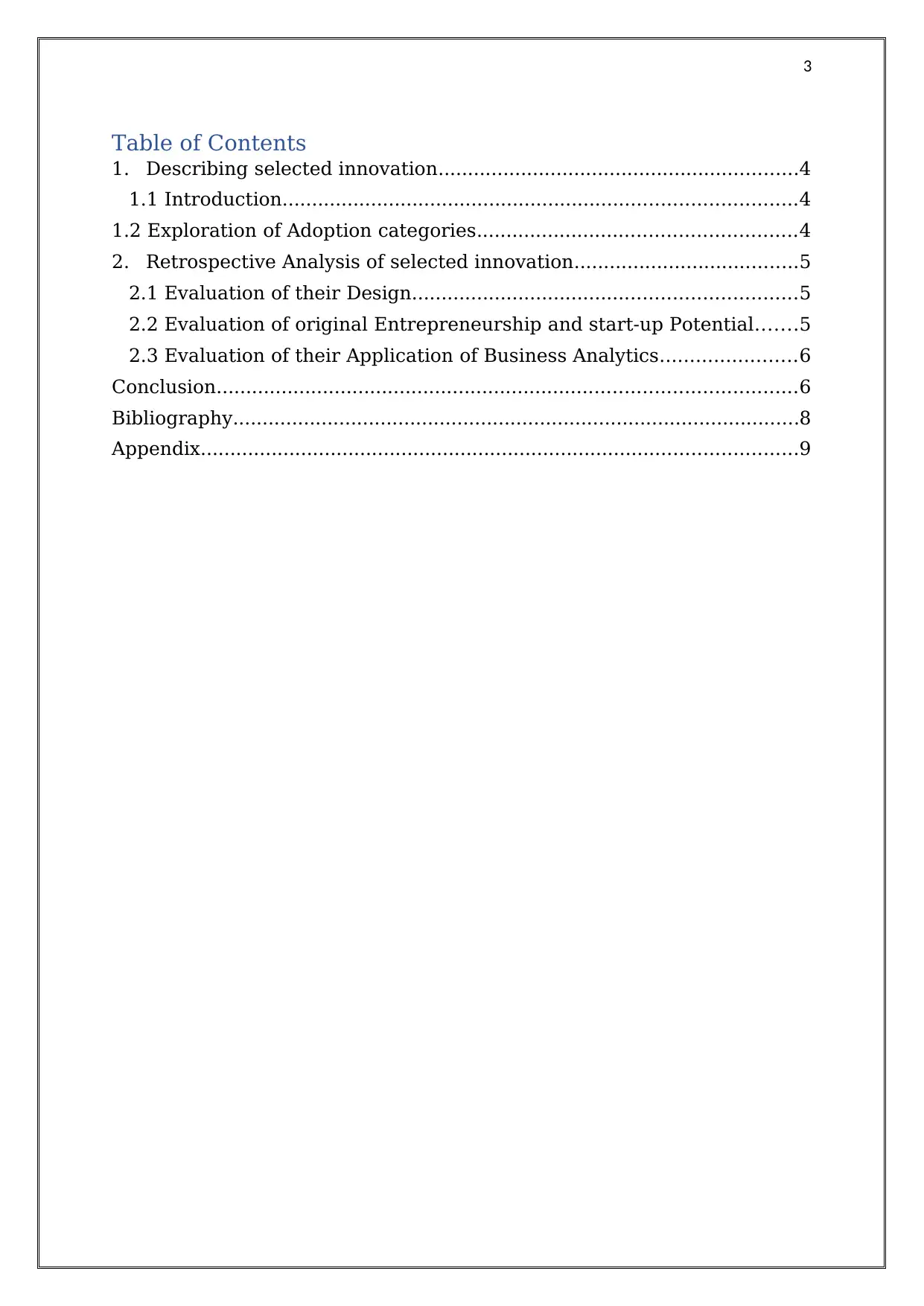
3
Table of Contents
1. Describing selected innovation.............................................................4
1.1 Introduction.......................................................................................4
1.2 Exploration of Adoption categories......................................................4
2. Retrospective Analysis of selected innovation......................................5
2.1 Evaluation of their Design.................................................................5
2.2 Evaluation of original Entrepreneurship and start-up Potential.......5
2.3 Evaluation of their Application of Business Analytics.......................6
Conclusion..................................................................................................6
Bibliography................................................................................................8
Appendix.....................................................................................................9
Table of Contents
1. Describing selected innovation.............................................................4
1.1 Introduction.......................................................................................4
1.2 Exploration of Adoption categories......................................................4
2. Retrospective Analysis of selected innovation......................................5
2.1 Evaluation of their Design.................................................................5
2.2 Evaluation of original Entrepreneurship and start-up Potential.......5
2.3 Evaluation of their Application of Business Analytics.......................6
Conclusion..................................................................................................6
Bibliography................................................................................................8
Appendix.....................................................................................................9
⊘ This is a preview!⊘
Do you want full access?
Subscribe today to unlock all pages.

Trusted by 1+ million students worldwide
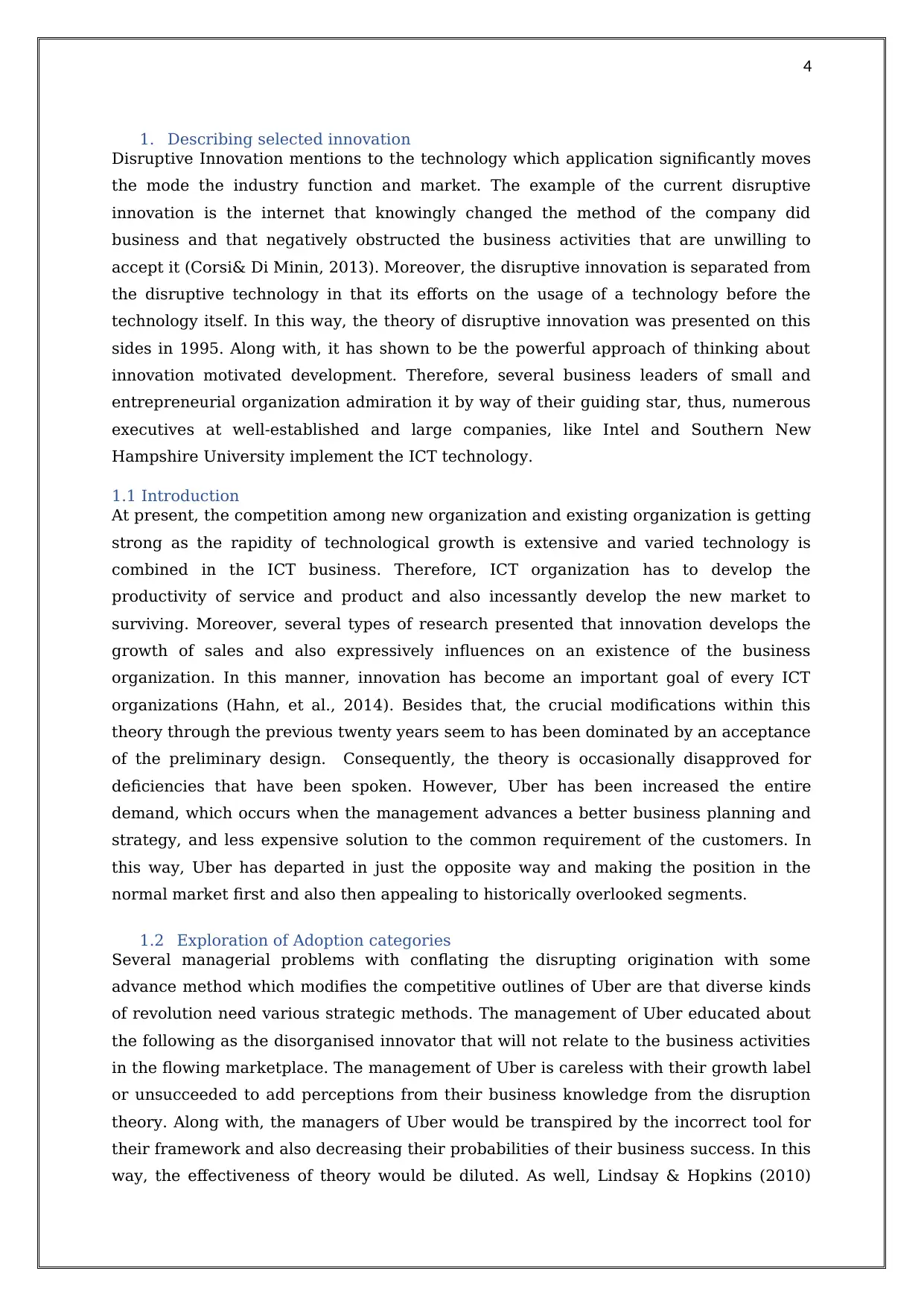
4
1. Describing selected innovation
Disruptive Innovation mentions to the technology which application significantly moves
the mode the industry function and market. The example of the current disruptive
innovation is the internet that knowingly changed the method of the company did
business and that negatively obstructed the business activities that are unwilling to
accept it (Corsi& Di Minin, 2013). Moreover, the disruptive innovation is separated from
the disruptive technology in that its efforts on the usage of a technology before the
technology itself. In this way, the theory of disruptive innovation was presented on this
sides in 1995. Along with, it has shown to be the powerful approach of thinking about
innovation motivated development. Therefore, several business leaders of small and
entrepreneurial organization admiration it by way of their guiding star, thus, numerous
executives at well-established and large companies, like Intel and Southern New
Hampshire University implement the ICT technology.
1.1 Introduction
At present, the competition among new organization and existing organization is getting
strong as the rapidity of technological growth is extensive and varied technology is
combined in the ICT business. Therefore, ICT organization has to develop the
productivity of service and product and also incessantly develop the new market to
surviving. Moreover, several types of research presented that innovation develops the
growth of sales and also expressively influences on an existence of the business
organization. In this manner, innovation has become an important goal of every ICT
organizations (Hahn, et al., 2014). Besides that, the crucial modifications within this
theory through the previous twenty years seem to has been dominated by an acceptance
of the preliminary design. Consequently, the theory is occasionally disapproved for
deficiencies that have been spoken. However, Uber has been increased the entire
demand, which occurs when the management advances a better business planning and
strategy, and less expensive solution to the common requirement of the customers. In
this way, Uber has departed in just the opposite way and making the position in the
normal market first and also then appealing to historically overlooked segments.
1.2 Exploration of Adoption categories
Several managerial problems with conflating the disrupting origination with some
advance method which modifies the competitive outlines of Uber are that diverse kinds
of revolution need various strategic methods. The management of Uber educated about
the following as the disorganised innovator that will not relate to the business activities
in the flowing marketplace. The management of Uber is careless with their growth label
or unsucceeded to add perceptions from their business knowledge from the disruption
theory. Along with, the managers of Uber would be transpired by the incorrect tool for
their framework and also decreasing their probabilities of their business success. In this
way, the effectiveness of theory would be diluted. As well, Lindsay & Hopkins (2010)
1. Describing selected innovation
Disruptive Innovation mentions to the technology which application significantly moves
the mode the industry function and market. The example of the current disruptive
innovation is the internet that knowingly changed the method of the company did
business and that negatively obstructed the business activities that are unwilling to
accept it (Corsi& Di Minin, 2013). Moreover, the disruptive innovation is separated from
the disruptive technology in that its efforts on the usage of a technology before the
technology itself. In this way, the theory of disruptive innovation was presented on this
sides in 1995. Along with, it has shown to be the powerful approach of thinking about
innovation motivated development. Therefore, several business leaders of small and
entrepreneurial organization admiration it by way of their guiding star, thus, numerous
executives at well-established and large companies, like Intel and Southern New
Hampshire University implement the ICT technology.
1.1 Introduction
At present, the competition among new organization and existing organization is getting
strong as the rapidity of technological growth is extensive and varied technology is
combined in the ICT business. Therefore, ICT organization has to develop the
productivity of service and product and also incessantly develop the new market to
surviving. Moreover, several types of research presented that innovation develops the
growth of sales and also expressively influences on an existence of the business
organization. In this manner, innovation has become an important goal of every ICT
organizations (Hahn, et al., 2014). Besides that, the crucial modifications within this
theory through the previous twenty years seem to has been dominated by an acceptance
of the preliminary design. Consequently, the theory is occasionally disapproved for
deficiencies that have been spoken. However, Uber has been increased the entire
demand, which occurs when the management advances a better business planning and
strategy, and less expensive solution to the common requirement of the customers. In
this way, Uber has departed in just the opposite way and making the position in the
normal market first and also then appealing to historically overlooked segments.
1.2 Exploration of Adoption categories
Several managerial problems with conflating the disrupting origination with some
advance method which modifies the competitive outlines of Uber are that diverse kinds
of revolution need various strategic methods. The management of Uber educated about
the following as the disorganised innovator that will not relate to the business activities
in the flowing marketplace. The management of Uber is careless with their growth label
or unsucceeded to add perceptions from their business knowledge from the disruption
theory. Along with, the managers of Uber would be transpired by the incorrect tool for
their framework and also decreasing their probabilities of their business success. In this
way, the effectiveness of theory would be diluted. As well, Lindsay & Hopkins (2010)
Paraphrase This Document
Need a fresh take? Get an instant paraphrase of this document with our AI Paraphraser
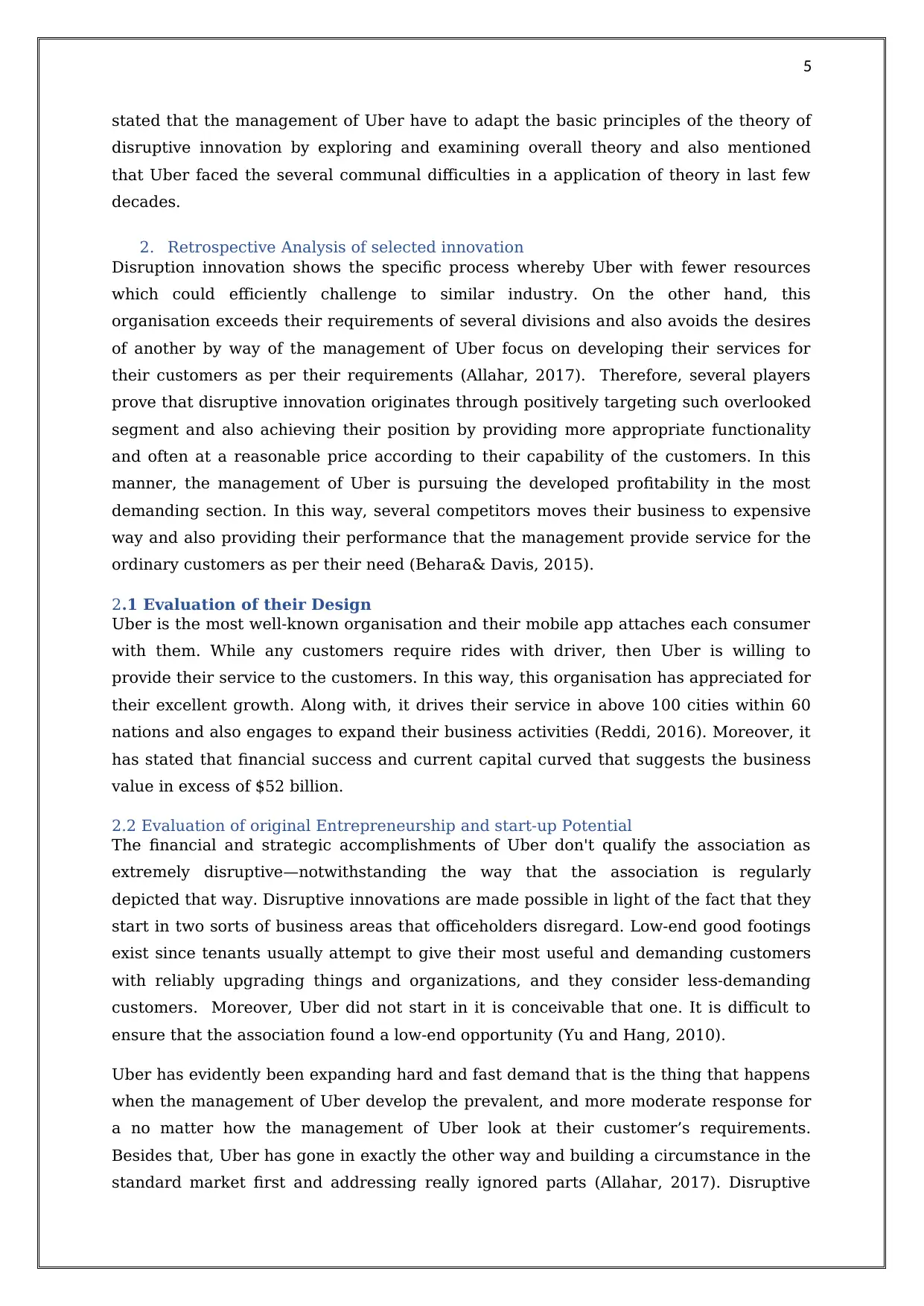
5
stated that the management of Uber have to adapt the basic principles of the theory of
disruptive innovation by exploring and examining overall theory and also mentioned
that Uber faced the several communal difficulties in a application of theory in last few
decades.
2. Retrospective Analysis of selected innovation
Disruption innovation shows the specific process whereby Uber with fewer resources
which could efficiently challenge to similar industry. On the other hand, this
organisation exceeds their requirements of several divisions and also avoids the desires
of another by way of the management of Uber focus on developing their services for
their customers as per their requirements (Allahar, 2017). Therefore, several players
prove that disruptive innovation originates through positively targeting such overlooked
segment and also achieving their position by providing more appropriate functionality
and often at a reasonable price according to their capability of the customers. In this
manner, the management of Uber is pursuing the developed profitability in the most
demanding section. In this way, several competitors moves their business to expensive
way and also providing their performance that the management provide service for the
ordinary customers as per their need (Behara& Davis, 2015).
2.1 Evaluation of their Design
Uber is the most well-known organisation and their mobile app attaches each consumer
with them. While any customers require rides with driver, then Uber is willing to
provide their service to the customers. In this way, this organisation has appreciated for
their excellent growth. Along with, it drives their service in above 100 cities within 60
nations and also engages to expand their business activities (Reddi, 2016). Moreover, it
has stated that financial success and current capital curved that suggests the business
value in excess of $52 billion.
2.2 Evaluation of original Entrepreneurship and start-up Potential
The financial and strategic accomplishments of Uber don't qualify the association as
extremely disruptive—notwithstanding the way that the association is regularly
depicted that way. Disruptive innovations are made possible in light of the fact that they
start in two sorts of business areas that officeholders disregard. Low-end good footings
exist since tenants usually attempt to give their most useful and demanding customers
with reliably upgrading things and organizations, and they consider less-demanding
customers. Moreover, Uber did not start in it is conceivable that one. It is difficult to
ensure that the association found a low-end opportunity (Yu and Hang, 2010).
Uber has evidently been expanding hard and fast demand that is the thing that happens
when the management of Uber develop the prevalent, and more moderate response for
a no matter how the management of Uber look at their customer’s requirements.
Besides that, Uber has gone in exactly the other way and building a circumstance in the
standard market first and addressing really ignored parts (Allahar, 2017). Disruptive
stated that the management of Uber have to adapt the basic principles of the theory of
disruptive innovation by exploring and examining overall theory and also mentioned
that Uber faced the several communal difficulties in a application of theory in last few
decades.
2. Retrospective Analysis of selected innovation
Disruption innovation shows the specific process whereby Uber with fewer resources
which could efficiently challenge to similar industry. On the other hand, this
organisation exceeds their requirements of several divisions and also avoids the desires
of another by way of the management of Uber focus on developing their services for
their customers as per their requirements (Allahar, 2017). Therefore, several players
prove that disruptive innovation originates through positively targeting such overlooked
segment and also achieving their position by providing more appropriate functionality
and often at a reasonable price according to their capability of the customers. In this
manner, the management of Uber is pursuing the developed profitability in the most
demanding section. In this way, several competitors moves their business to expensive
way and also providing their performance that the management provide service for the
ordinary customers as per their need (Behara& Davis, 2015).
2.1 Evaluation of their Design
Uber is the most well-known organisation and their mobile app attaches each consumer
with them. While any customers require rides with driver, then Uber is willing to
provide their service to the customers. In this way, this organisation has appreciated for
their excellent growth. Along with, it drives their service in above 100 cities within 60
nations and also engages to expand their business activities (Reddi, 2016). Moreover, it
has stated that financial success and current capital curved that suggests the business
value in excess of $52 billion.
2.2 Evaluation of original Entrepreneurship and start-up Potential
The financial and strategic accomplishments of Uber don't qualify the association as
extremely disruptive—notwithstanding the way that the association is regularly
depicted that way. Disruptive innovations are made possible in light of the fact that they
start in two sorts of business areas that officeholders disregard. Low-end good footings
exist since tenants usually attempt to give their most useful and demanding customers
with reliably upgrading things and organizations, and they consider less-demanding
customers. Moreover, Uber did not start in it is conceivable that one. It is difficult to
ensure that the association found a low-end opportunity (Yu and Hang, 2010).
Uber has evidently been expanding hard and fast demand that is the thing that happens
when the management of Uber develop the prevalent, and more moderate response for
a no matter how the management of Uber look at their customer’s requirements.
Besides that, Uber has gone in exactly the other way and building a circumstance in the
standard market first and addressing really ignored parts (Allahar, 2017). Disruptive
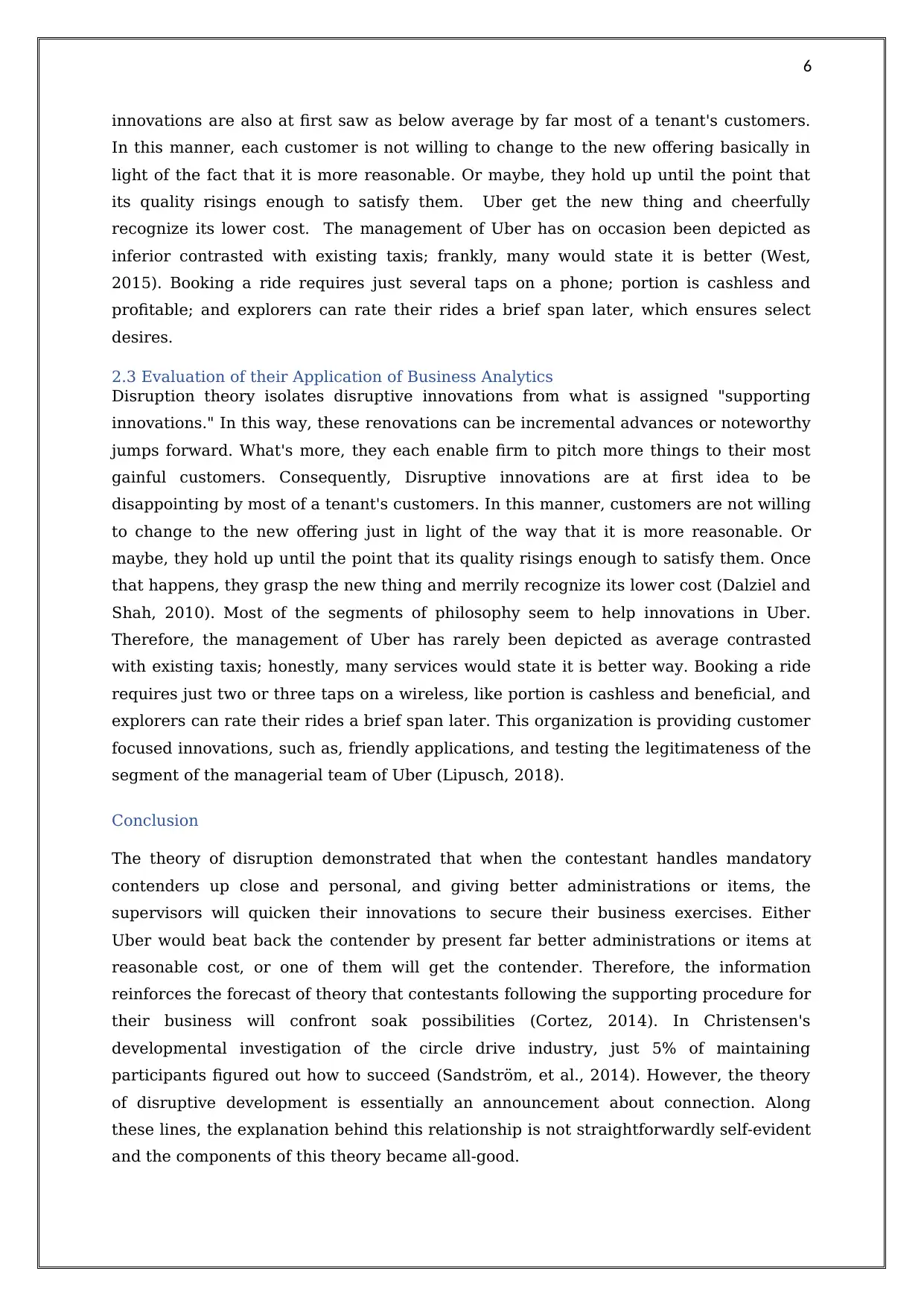
6
innovations are also at first saw as below average by far most of a tenant's customers.
In this manner, each customer is not willing to change to the new offering basically in
light of the fact that it is more reasonable. Or maybe, they hold up until the point that
its quality risings enough to satisfy them. Uber get the new thing and cheerfully
recognize its lower cost. The management of Uber has on occasion been depicted as
inferior contrasted with existing taxis; frankly, many would state it is better (West,
2015). Booking a ride requires just several taps on a phone; portion is cashless and
profitable; and explorers can rate their rides a brief span later, which ensures select
desires.
2.3 Evaluation of their Application of Business Analytics
Disruption theory isolates disruptive innovations from what is assigned "supporting
innovations." In this way, these renovations can be incremental advances or noteworthy
jumps forward. What's more, they each enable firm to pitch more things to their most
gainful customers. Consequently, Disruptive innovations are at first idea to be
disappointing by most of a tenant's customers. In this manner, customers are not willing
to change to the new offering just in light of the way that it is more reasonable. Or
maybe, they hold up until the point that its quality risings enough to satisfy them. Once
that happens, they grasp the new thing and merrily recognize its lower cost (Dalziel and
Shah, 2010). Most of the segments of philosophy seem to help innovations in Uber.
Therefore, the management of Uber has rarely been depicted as average contrasted
with existing taxis; honestly, many services would state it is better way. Booking a ride
requires just two or three taps on a wireless, like portion is cashless and beneficial, and
explorers can rate their rides a brief span later. This organization is providing customer
focused innovations, such as, friendly applications, and testing the legitimateness of the
segment of the managerial team of Uber (Lipusch, 2018).
Conclusion
The theory of disruption demonstrated that when the contestant handles mandatory
contenders up close and personal, and giving better administrations or items, the
supervisors will quicken their innovations to secure their business exercises. Either
Uber would beat back the contender by present far better administrations or items at
reasonable cost, or one of them will get the contender. Therefore, the information
reinforces the forecast of theory that contestants following the supporting procedure for
their business will confront soak possibilities (Cortez, 2014). In Christensen's
developmental investigation of the circle drive industry, just 5% of maintaining
participants figured out how to succeed (Sandström, et al., 2014). However, the theory
of disruptive development is essentially an announcement about connection. Along
these lines, the explanation behind this relationship is not straightforwardly self-evident
and the components of this theory became all-good.
innovations are also at first saw as below average by far most of a tenant's customers.
In this manner, each customer is not willing to change to the new offering basically in
light of the fact that it is more reasonable. Or maybe, they hold up until the point that
its quality risings enough to satisfy them. Uber get the new thing and cheerfully
recognize its lower cost. The management of Uber has on occasion been depicted as
inferior contrasted with existing taxis; frankly, many would state it is better (West,
2015). Booking a ride requires just several taps on a phone; portion is cashless and
profitable; and explorers can rate their rides a brief span later, which ensures select
desires.
2.3 Evaluation of their Application of Business Analytics
Disruption theory isolates disruptive innovations from what is assigned "supporting
innovations." In this way, these renovations can be incremental advances or noteworthy
jumps forward. What's more, they each enable firm to pitch more things to their most
gainful customers. Consequently, Disruptive innovations are at first idea to be
disappointing by most of a tenant's customers. In this manner, customers are not willing
to change to the new offering just in light of the way that it is more reasonable. Or
maybe, they hold up until the point that its quality risings enough to satisfy them. Once
that happens, they grasp the new thing and merrily recognize its lower cost (Dalziel and
Shah, 2010). Most of the segments of philosophy seem to help innovations in Uber.
Therefore, the management of Uber has rarely been depicted as average contrasted
with existing taxis; honestly, many services would state it is better way. Booking a ride
requires just two or three taps on a wireless, like portion is cashless and beneficial, and
explorers can rate their rides a brief span later. This organization is providing customer
focused innovations, such as, friendly applications, and testing the legitimateness of the
segment of the managerial team of Uber (Lipusch, 2018).
Conclusion
The theory of disruption demonstrated that when the contestant handles mandatory
contenders up close and personal, and giving better administrations or items, the
supervisors will quicken their innovations to secure their business exercises. Either
Uber would beat back the contender by present far better administrations or items at
reasonable cost, or one of them will get the contender. Therefore, the information
reinforces the forecast of theory that contestants following the supporting procedure for
their business will confront soak possibilities (Cortez, 2014). In Christensen's
developmental investigation of the circle drive industry, just 5% of maintaining
participants figured out how to succeed (Sandström, et al., 2014). However, the theory
of disruptive development is essentially an announcement about connection. Along
these lines, the explanation behind this relationship is not straightforwardly self-evident
and the components of this theory became all-good.
⊘ This is a preview!⊘
Do you want full access?
Subscribe today to unlock all pages.

Trusted by 1+ million students worldwide
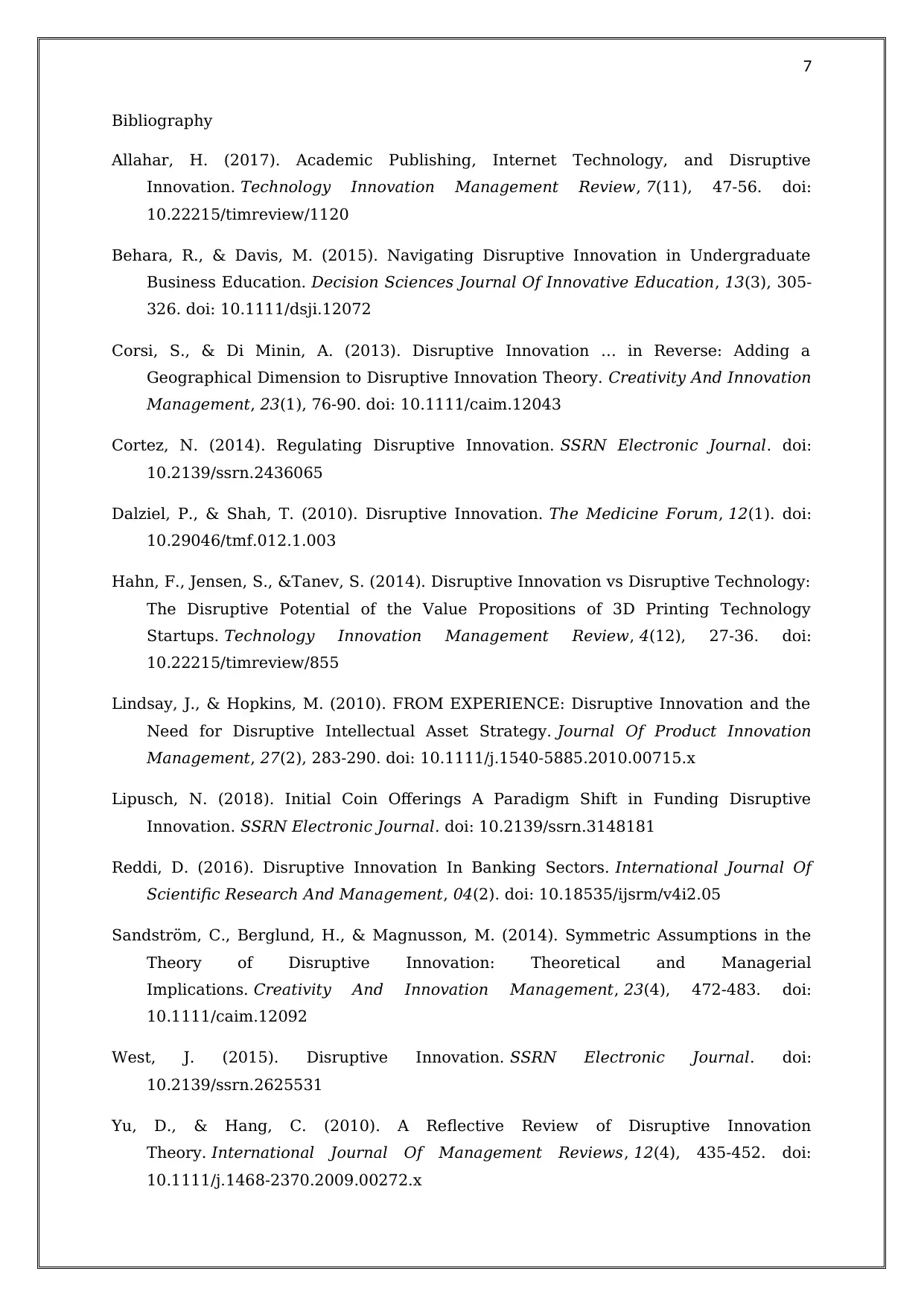
7
Bibliography
Allahar, H. (2017). Academic Publishing, Internet Technology, and Disruptive
Innovation. Technology Innovation Management Review, 7(11), 47-56. doi:
10.22215/timreview/1120
Behara, R., & Davis, M. (2015). Navigating Disruptive Innovation in Undergraduate
Business Education. Decision Sciences Journal Of Innovative Education, 13(3), 305-
326. doi: 10.1111/dsji.12072
Corsi, S., & Di Minin, A. (2013). Disruptive Innovation … in Reverse: Adding a
Geographical Dimension to Disruptive Innovation Theory. Creativity And Innovation
Management, 23(1), 76-90. doi: 10.1111/caim.12043
Cortez, N. (2014). Regulating Disruptive Innovation. SSRN Electronic Journal. doi:
10.2139/ssrn.2436065
Dalziel, P., & Shah, T. (2010). Disruptive Innovation. The Medicine Forum, 12(1). doi:
10.29046/tmf.012.1.003
Hahn, F., Jensen, S., &Tanev, S. (2014). Disruptive Innovation vs Disruptive Technology:
The Disruptive Potential of the Value Propositions of 3D Printing Technology
Startups. Technology Innovation Management Review, 4(12), 27-36. doi:
10.22215/timreview/855
Lindsay, J., & Hopkins, M. (2010). FROM EXPERIENCE: Disruptive Innovation and the
Need for Disruptive Intellectual Asset Strategy. Journal Of Product Innovation
Management, 27(2), 283-290. doi: 10.1111/j.1540-5885.2010.00715.x
Lipusch, N. (2018). Initial Coin Offerings A Paradigm Shift in Funding Disruptive
Innovation. SSRN Electronic Journal. doi: 10.2139/ssrn.3148181
Reddi, D. (2016). Disruptive Innovation In Banking Sectors. International Journal Of
Scientific Research And Management, 04(2). doi: 10.18535/ijsrm/v4i2.05
Sandström, C., Berglund, H., & Magnusson, M. (2014). Symmetric Assumptions in the
Theory of Disruptive Innovation: Theoretical and Managerial
Implications. Creativity And Innovation Management, 23(4), 472-483. doi:
10.1111/caim.12092
West, J. (2015). Disruptive Innovation. SSRN Electronic Journal. doi:
10.2139/ssrn.2625531
Yu, D., & Hang, C. (2010). A Reflective Review of Disruptive Innovation
Theory. International Journal Of Management Reviews, 12(4), 435-452. doi:
10.1111/j.1468-2370.2009.00272.x
Bibliography
Allahar, H. (2017). Academic Publishing, Internet Technology, and Disruptive
Innovation. Technology Innovation Management Review, 7(11), 47-56. doi:
10.22215/timreview/1120
Behara, R., & Davis, M. (2015). Navigating Disruptive Innovation in Undergraduate
Business Education. Decision Sciences Journal Of Innovative Education, 13(3), 305-
326. doi: 10.1111/dsji.12072
Corsi, S., & Di Minin, A. (2013). Disruptive Innovation … in Reverse: Adding a
Geographical Dimension to Disruptive Innovation Theory. Creativity And Innovation
Management, 23(1), 76-90. doi: 10.1111/caim.12043
Cortez, N. (2014). Regulating Disruptive Innovation. SSRN Electronic Journal. doi:
10.2139/ssrn.2436065
Dalziel, P., & Shah, T. (2010). Disruptive Innovation. The Medicine Forum, 12(1). doi:
10.29046/tmf.012.1.003
Hahn, F., Jensen, S., &Tanev, S. (2014). Disruptive Innovation vs Disruptive Technology:
The Disruptive Potential of the Value Propositions of 3D Printing Technology
Startups. Technology Innovation Management Review, 4(12), 27-36. doi:
10.22215/timreview/855
Lindsay, J., & Hopkins, M. (2010). FROM EXPERIENCE: Disruptive Innovation and the
Need for Disruptive Intellectual Asset Strategy. Journal Of Product Innovation
Management, 27(2), 283-290. doi: 10.1111/j.1540-5885.2010.00715.x
Lipusch, N. (2018). Initial Coin Offerings A Paradigm Shift in Funding Disruptive
Innovation. SSRN Electronic Journal. doi: 10.2139/ssrn.3148181
Reddi, D. (2016). Disruptive Innovation In Banking Sectors. International Journal Of
Scientific Research And Management, 04(2). doi: 10.18535/ijsrm/v4i2.05
Sandström, C., Berglund, H., & Magnusson, M. (2014). Symmetric Assumptions in the
Theory of Disruptive Innovation: Theoretical and Managerial
Implications. Creativity And Innovation Management, 23(4), 472-483. doi:
10.1111/caim.12092
West, J. (2015). Disruptive Innovation. SSRN Electronic Journal. doi:
10.2139/ssrn.2625531
Yu, D., & Hang, C. (2010). A Reflective Review of Disruptive Innovation
Theory. International Journal Of Management Reviews, 12(4), 435-452. doi:
10.1111/j.1468-2370.2009.00272.x
Paraphrase This Document
Need a fresh take? Get an instant paraphrase of this document with our AI Paraphraser

8
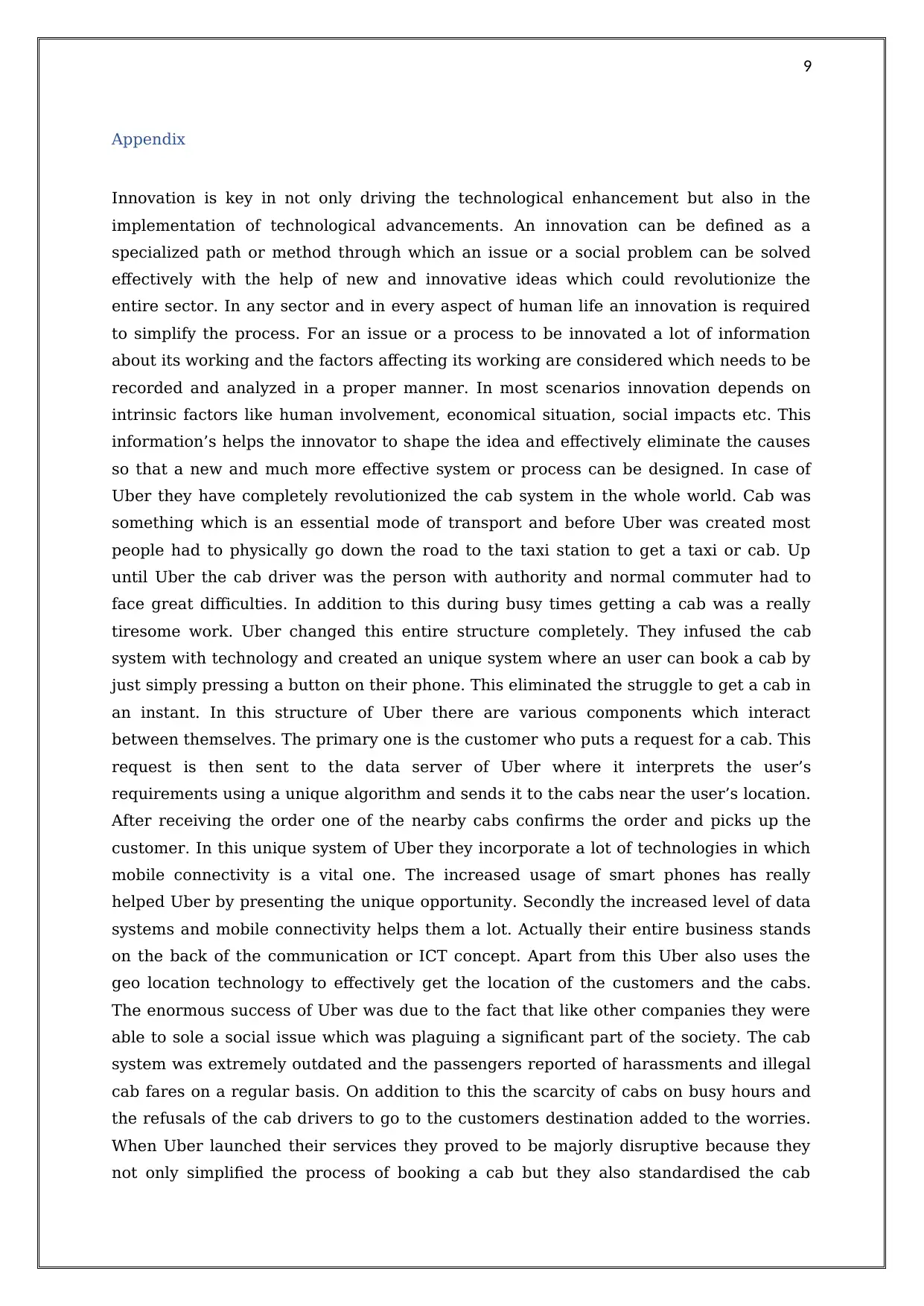
9
Appendix
Innovation is key in not only driving the technological enhancement but also in the
implementation of technological advancements. An innovation can be defined as a
specialized path or method through which an issue or a social problem can be solved
effectively with the help of new and innovative ideas which could revolutionize the
entire sector. In any sector and in every aspect of human life an innovation is required
to simplify the process. For an issue or a process to be innovated a lot of information
about its working and the factors affecting its working are considered which needs to be
recorded and analyzed in a proper manner. In most scenarios innovation depends on
intrinsic factors like human involvement, economical situation, social impacts etc. This
information’s helps the innovator to shape the idea and effectively eliminate the causes
so that a new and much more effective system or process can be designed. In case of
Uber they have completely revolutionized the cab system in the whole world. Cab was
something which is an essential mode of transport and before Uber was created most
people had to physically go down the road to the taxi station to get a taxi or cab. Up
until Uber the cab driver was the person with authority and normal commuter had to
face great difficulties. In addition to this during busy times getting a cab was a really
tiresome work. Uber changed this entire structure completely. They infused the cab
system with technology and created an unique system where an user can book a cab by
just simply pressing a button on their phone. This eliminated the struggle to get a cab in
an instant. In this structure of Uber there are various components which interact
between themselves. The primary one is the customer who puts a request for a cab. This
request is then sent to the data server of Uber where it interprets the user’s
requirements using a unique algorithm and sends it to the cabs near the user’s location.
After receiving the order one of the nearby cabs confirms the order and picks up the
customer. In this unique system of Uber they incorporate a lot of technologies in which
mobile connectivity is a vital one. The increased usage of smart phones has really
helped Uber by presenting the unique opportunity. Secondly the increased level of data
systems and mobile connectivity helps them a lot. Actually their entire business stands
on the back of the communication or ICT concept. Apart from this Uber also uses the
geo location technology to effectively get the location of the customers and the cabs.
The enormous success of Uber was due to the fact that like other companies they were
able to sole a social issue which was plaguing a significant part of the society. The cab
system was extremely outdated and the passengers reported of harassments and illegal
cab fares on a regular basis. On addition to this the scarcity of cabs on busy hours and
the refusals of the cab drivers to go to the customers destination added to the worries.
When Uber launched their services they proved to be majorly disruptive because they
not only simplified the process of booking a cab but they also standardised the cab
Appendix
Innovation is key in not only driving the technological enhancement but also in the
implementation of technological advancements. An innovation can be defined as a
specialized path or method through which an issue or a social problem can be solved
effectively with the help of new and innovative ideas which could revolutionize the
entire sector. In any sector and in every aspect of human life an innovation is required
to simplify the process. For an issue or a process to be innovated a lot of information
about its working and the factors affecting its working are considered which needs to be
recorded and analyzed in a proper manner. In most scenarios innovation depends on
intrinsic factors like human involvement, economical situation, social impacts etc. This
information’s helps the innovator to shape the idea and effectively eliminate the causes
so that a new and much more effective system or process can be designed. In case of
Uber they have completely revolutionized the cab system in the whole world. Cab was
something which is an essential mode of transport and before Uber was created most
people had to physically go down the road to the taxi station to get a taxi or cab. Up
until Uber the cab driver was the person with authority and normal commuter had to
face great difficulties. In addition to this during busy times getting a cab was a really
tiresome work. Uber changed this entire structure completely. They infused the cab
system with technology and created an unique system where an user can book a cab by
just simply pressing a button on their phone. This eliminated the struggle to get a cab in
an instant. In this structure of Uber there are various components which interact
between themselves. The primary one is the customer who puts a request for a cab. This
request is then sent to the data server of Uber where it interprets the user’s
requirements using a unique algorithm and sends it to the cabs near the user’s location.
After receiving the order one of the nearby cabs confirms the order and picks up the
customer. In this unique system of Uber they incorporate a lot of technologies in which
mobile connectivity is a vital one. The increased usage of smart phones has really
helped Uber by presenting the unique opportunity. Secondly the increased level of data
systems and mobile connectivity helps them a lot. Actually their entire business stands
on the back of the communication or ICT concept. Apart from this Uber also uses the
geo location technology to effectively get the location of the customers and the cabs.
The enormous success of Uber was due to the fact that like other companies they were
able to sole a social issue which was plaguing a significant part of the society. The cab
system was extremely outdated and the passengers reported of harassments and illegal
cab fares on a regular basis. On addition to this the scarcity of cabs on busy hours and
the refusals of the cab drivers to go to the customers destination added to the worries.
When Uber launched their services they proved to be majorly disruptive because they
not only simplified the process of booking a cab but they also standardised the cab
⊘ This is a preview!⊘
Do you want full access?
Subscribe today to unlock all pages.

Trusted by 1+ million students worldwide
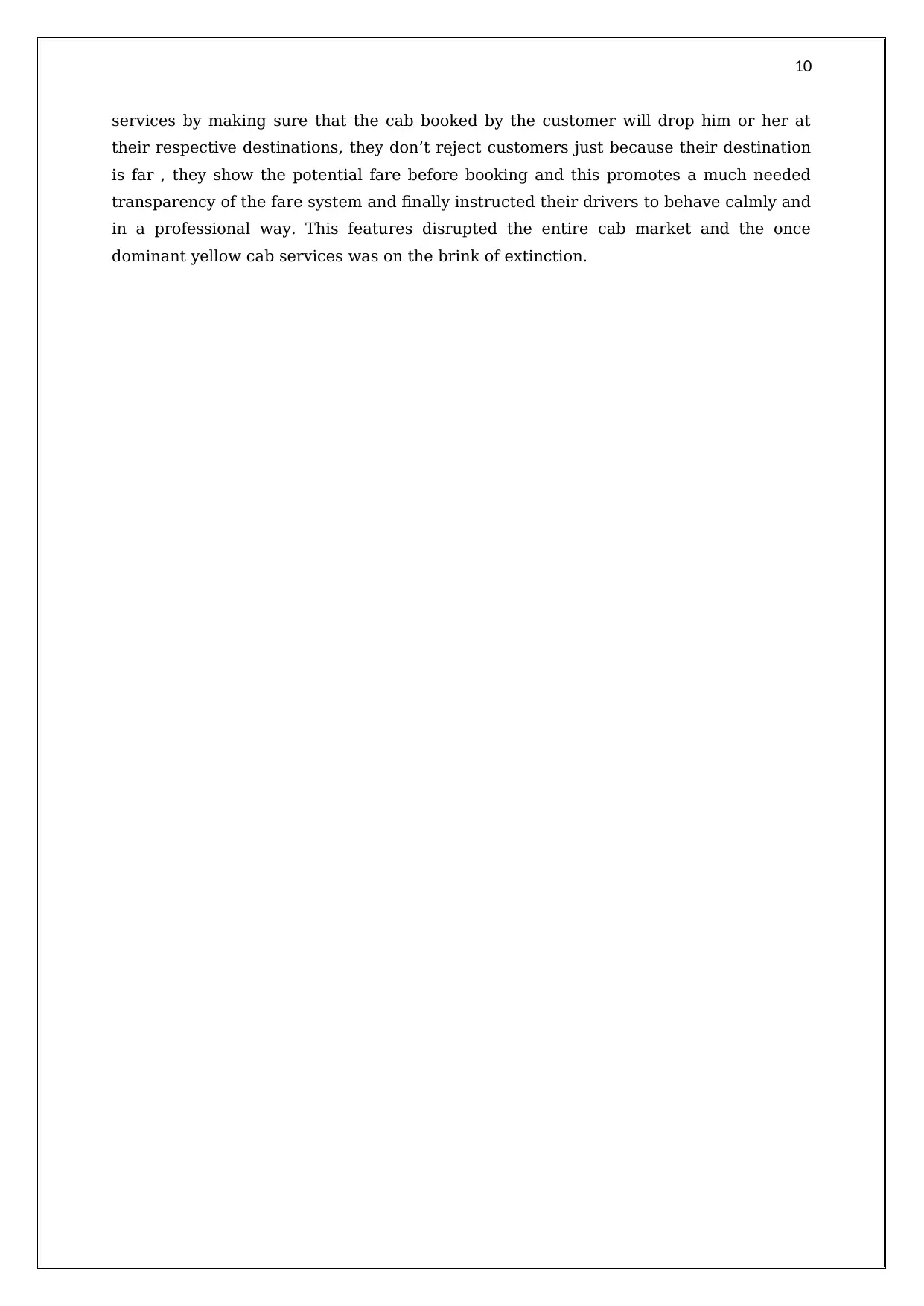
10
services by making sure that the cab booked by the customer will drop him or her at
their respective destinations, they don’t reject customers just because their destination
is far , they show the potential fare before booking and this promotes a much needed
transparency of the fare system and finally instructed their drivers to behave calmly and
in a professional way. This features disrupted the entire cab market and the once
dominant yellow cab services was on the brink of extinction.
services by making sure that the cab booked by the customer will drop him or her at
their respective destinations, they don’t reject customers just because their destination
is far , they show the potential fare before booking and this promotes a much needed
transparency of the fare system and finally instructed their drivers to behave calmly and
in a professional way. This features disrupted the entire cab market and the once
dominant yellow cab services was on the brink of extinction.
1 out of 10
Related Documents
Your All-in-One AI-Powered Toolkit for Academic Success.
+13062052269
info@desklib.com
Available 24*7 on WhatsApp / Email
![[object Object]](/_next/static/media/star-bottom.7253800d.svg)
Unlock your academic potential
Copyright © 2020–2025 A2Z Services. All Rights Reserved. Developed and managed by ZUCOL.




